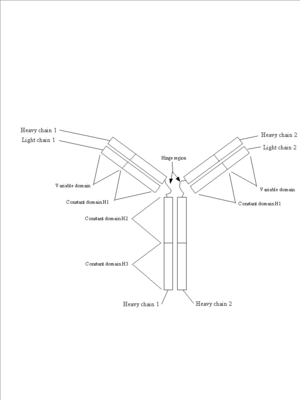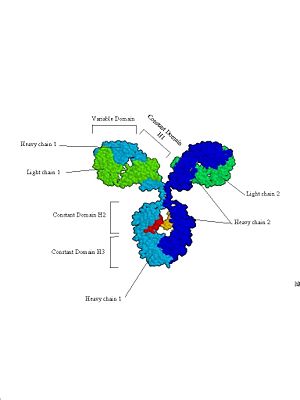Phillips Academy Computer-Aided Protein Visualization Lab
From Proteopedia
(Difference between revisions)
(New page: == Introduction to Computer-Aided Protein Visualization Lab == <StructureSection load='1pgb' size='340' side='right' caption='This simple protein, B1 Immunoglobulin-binding domain of Strep...) |
|||
| (15 intermediate revisions not shown.) | |||
| Line 1: | Line 1: | ||
== Introduction to Computer-Aided Protein Visualization Lab == | == Introduction to Computer-Aided Protein Visualization Lab == | ||
| - | <StructureSection load='1pgb' size='340' side='right' caption='This simple protein, B1 Immunoglobulin-binding domain of Streptococcal protein G, shows secondary structures nicely. The alpha helix is red, beta sheet in yellow.' scene=' | + | <StructureSection load='1pgb' size='340' side='right' caption='This simple protein, B1 Immunoglobulin-binding domain of Streptococcal protein G, shows secondary structures nicely. The alpha helix is red, beta sheet in yellow.' scene='79/795987/Pg/1'> |
== Computer-Aided Protein Visualization Lab == | == Computer-Aided Protein Visualization Lab == | ||
Knowing the three-dimensional structure of a protein can be a very powerful tool for biologists. Much can be learned about enzyme function, interaction of molecules in your immune system, the appearance of the surface of viruses, and the interaction of ligands and receptors. | Knowing the three-dimensional structure of a protein can be a very powerful tool for biologists. Much can be learned about enzyme function, interaction of molecules in your immune system, the appearance of the surface of viruses, and the interaction of ligands and receptors. | ||
One particularly key area of current research is the design of drugs against specific protein targets. Scientists may look for drugs to block the activity of an enzyme of an attacking bacteria, protist or virus. After first finding an enzyme that is slightly different between humans and the invading species, the scientists can then use computers to look at the enzyme and try to fit tens of thousands of compounds into the enzyme in such a way as to block its activity; most commonly this involves plugging the active site of the invading species enzyme selectively. Using computers to analyze this problem can speed up the screening of 50,000 potential drugs from many years down to one week! Once a few compounds with potential are approved by the computer, the scientist can look to chemically modify those compounds to make them even better and then try them out in drug trials against the enzyme in test tubes, and eventually in drug trials in animals and humans. | One particularly key area of current research is the design of drugs against specific protein targets. Scientists may look for drugs to block the activity of an enzyme of an attacking bacteria, protist or virus. After first finding an enzyme that is slightly different between humans and the invading species, the scientists can then use computers to look at the enzyme and try to fit tens of thousands of compounds into the enzyme in such a way as to block its activity; most commonly this involves plugging the active site of the invading species enzyme selectively. Using computers to analyze this problem can speed up the screening of 50,000 potential drugs from many years down to one week! Once a few compounds with potential are approved by the computer, the scientist can look to chemically modify those compounds to make them even better and then try them out in drug trials against the enzyme in test tubes, and eventually in drug trials in animals and humans. | ||
| - | == First some background: (make sure that you understand the | + | == First some background: (make sure that you understand the '''bold''' words)== |
| - | Proteins are synthesized on ribosomes by linking together many amino acids into a long chain. If you could observe a protein as it is made, it would look like a string of pearls (amino acids) feeding out the end of the ribosome as it floats in the cytoplasm of the cell ([https://www.dnalc.org/view/15501-Translation-RNA-to-protein-3D-animation-with-basic-narration.html Video of Translation (DNALC)]). This structure is called the primary structure (or 1° structure) and refers to the sequence of amino acids of the protein. After protein synthesis has started, | + | '''Proteins''' are synthesized on '''ribosomes''' by linking together many '''amino acids''' into a long chain. If you could observe a protein as it is made, it would look like a string of pearls (amino acids) feeding out the end of the ribosome as it floats in the '''cytoplasm''' of the '''cell''' ([https://www.dnalc.org/view/15501-Translation-RNA-to-protein-3D-animation-with-basic-narration.html Video of Translation (DNALC)]). This structure is called the '''primary structure''' (or 1° structure) and refers to the sequence of amino acids of the protein. After protein synthesis has started, the sequence of amino acids will begin to fold into a 3-dimensional structure. This process is called '''protein folding''': |
| - | + | Protein folding: | |
| - | + | The most important rule about protein structure is that it is determined by the primary sequence of the protein. Protein folding is a complicated multi-step process. The first step results in the '''secondary structure''' (or 2° structure) of the protein. Secondary structures come in two flavors: '''alpha helices''' and '''beta sheets''' (or beta-pleated sheets). Alpha helices are spiral staircase structures (see structure 1 below), and beta-pleated sheets are flat regions where the amino acids run back and forth next to each other in long ribbons (see structure 2 below). These two structures form spontaneously based on the shape/'''hydrophobicity'''/'''charges''' of the amino acids and are held together by '''hydrogen bonds'''. The protein will now look like a string of pearls with twists or zig-zags at intervals along its length. | |
| - | + | For all of the protein structures you will visualize below, once you click on the green link, the structure will appear in the structure window on the right side of the page. In the structure window, click on "Popup" button to open a larger popup window of this structure. You can toggle the spin of the structure on or off by clicking on the "Spin" button. Clicking and holding on the structure in the window will allow you to manipulate the structure, rotating in three-dimension. | |
| - | + | On the right side of this window you will our first example of a protein represented in three dimensions. This is protein G from the Streptococcal bacterium....a small and very simple polypeptide that binds to antibodies and messes up their organization such that their ability to further activate an immune response is hampered. | |
| - | 1. <scene name=' | + | ''Secondary Structure'': As you can see in this cartoon representation of protein G, there are two main sub-structures (secondary structure) of this protein. In red is the alpha helix, while a beta sheet is in gold. The regions linking the alpha helix and beta sheets together are called turns or linking regions (in white) and are not considered to be discrete secondary structures since they are not tightly structured and tend to be floppy. |
| - | < | + | |
| - | 2. <scene name=' | + | 1.Alpha helix <scene name='79/795987/Pg/9'>Click to see alpha helix in relation to beta sheet</scene> Here you can see the alpha helix of protein G in red and in ball and stick representation. The beta sheet is gold, in cartoon representation. Now <scene name='79/795987/Pg/7'>click to view alpha helix in isolation</scene>. Here the alpha helix is completely isolated. The rest of the protein is hidden. The '''amino acid backbone''' (the parts of the amino acids that are linked together by a '''peptide bond''' to form the primary sequence) is shown in red. The '''amino acid side chains''' are shown in tan (each type of amino acid has its own unique side chain, one of 20 different types). |
| + | |||
| + | 2.Beta sheet <scene name='79/795987/Pg/4'>Click to see the beta sheet in relation to the alpha helix</scene> Here you can see the beta sheet of protein G gold, ball and stick representation. The alpha helix is red and in cartoon representation. Now <scene name='79/795987/Pg/8'>click to see beta sheet in isolation</scene>. Here it the beta sheet is completely isolated. The rest of the protein is hidden. The amino acid backbone is in gold, the side chains in light blue. | ||
<br> | <br> | ||
| - | + | ||
| - | The second step of protein folding results in the tertiary structure (or 3° structure). Tertiary structure gives the protein an overall three-dimensional structure. The tertiary structure of a protein is determined by a combination of factors including hydrogen bonds, ionic bonds (between positively and negatively charged amino acids), covalent disulfide bonds (between cysteine residues), and Van der Waals interactions. Tertiary structure can also be affected by repulsive forces between similarly charged amino acids, as well as hydrophobic and hydrophilic interactions with a solvent (commonly water). At a distance many proteins form what look to be large globs at this point, and it is only upon more careful and close up inspection that one can see the true uniqueness of the shape. | + | ''Tertiary structure'': The second step of protein folding results in the '''tertiary structure''' (or 3° structure). Tertiary structure gives the protein an overall three-dimensional structure. The tertiary structure of a protein is determined by a combination of factors including hydrogen bonds, '''ionic bonds''' (between positively and negatively charged amino acids), '''covalent bonds''' '''disulfide bonds''' (between cysteine residues), and '''Van der Waals''' interactions. Tertiary structure can also be affected by repulsive forces between similarly charged amino acids, as well as '''hydrophobic''' and '''hydrophilic''' interactions with a solvent (commonly water). At a distance many proteins form what look to be large globs at this point, and it is only upon more careful and close up inspection that one can see the true uniqueness of the shape. |
<br> | <br> | ||
[[Image:Intramolecular forces in tertiary structures.png]] | [[Image:Intramolecular forces in tertiary structures.png]] | ||
| - | Figure 3: The various intramolecular interactions that help determine | + | Figure 3: The various intramolecular interactions that help determine tertiary structure |
Proteins may contain only alpha helices, only beta sheets, or a combination of the two. The same holds true for the bonds giving a protein its tertiary structure - all, some or none may be present. These different folding patterns existing in different proteins are what give the proteins their distinctive shapes and sizes. A protein that is 300 amino acids long will be 100 nm as an extended chain. If the protein is an alpha helix, it will be 45 nm long; a beta sheet will be 7 x 7 x 0.8 nm; and a small globular form will form a sphere only 4.5 nm in diameter! | Proteins may contain only alpha helices, only beta sheets, or a combination of the two. The same holds true for the bonds giving a protein its tertiary structure - all, some or none may be present. These different folding patterns existing in different proteins are what give the proteins their distinctive shapes and sizes. A protein that is 300 amino acids long will be 100 nm as an extended chain. If the protein is an alpha helix, it will be 45 nm long; a beta sheet will be 7 x 7 x 0.8 nm; and a small globular form will form a sphere only 4.5 nm in diameter! | ||
| Line 93: | Line 95: | ||
2.[http://proteopedia.org/wiki/index.php/User:Jeremiah_C_Hagler/Sandbox_3 Protein 3: HIV Reverse Transcriptase] | 2.[http://proteopedia.org/wiki/index.php/User:Jeremiah_C_Hagler/Sandbox_3 Protein 3: HIV Reverse Transcriptase] | ||
<br> | <br> | ||
| - | 3.[http://proteopedia.org/wiki/index.php/User:Jeremiah_C_Hagler/Sandbox_1 Protein 2: Alkaline Phosphatase] | + | 3.[http://proteopedia.org/wiki/index.php/User:Jeremiah_C_Hagler/Sandbox_1 Protein 2: Alkaline Phosphatase] <scene name='79/795987/Ap/1'>Alkaline Phosphatase</scene> |
<br> | <br> | ||
<references/> | <references/> | ||
Current revision
Introduction to Computer-Aided Protein Visualization Lab
| |||||||||||



